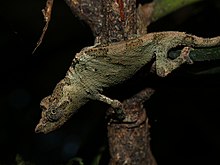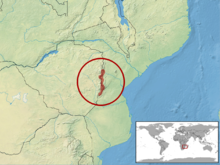| Marshall's pygmy chameleon | |
|---|---|

| |
| Conservation status | |
 Vulnerable (IUCN 3.1) | |
| Scientific classification | |
| Domain: | Eukaryota |
| Kingdom: | Animalia |
| Phylum: | Chordata |
| Class: | Reptilia |
| Order: | Squamata |
| Suborder: | Iguania |
| Family: | Chamaeleonidae |
| Genus: | Rhampholeon |
| Species: | R. marshalli |
| Binomial name | |
| Rhampholeon marshalli Boulenger, 1906 | |

| |
Marshall's pygmy chameleon (Rhampholeon marshalli), also called Marshall's leaf chameleon, Marshall's dwarf chameleon, or Marshall's stumptail chameleon, is a species of chameleon found in the forests of Zimbabwe and Mozambique in Africa. It grows from 3.5 to 7.5 cm (1.4 to 3.0 in) and feeds on insects. When standing still, it resembles a leaf on a branch.
Etymology
The specific name, marshalli, is in honor of British entomologist Guy Anstruther Knox Marshall, who collected the holotype.
Identification
Marshall's leaf chameleon is unmistakable. It is the only such tiny chameleon in its range (sympatric with Chamaeleo dilepis quilensis, the flap-necked chameleon to a degree). This is a tiny species of 3.2–7.5 cm (1.3–3.0 in), females being slightly larger. Isolated populations have distinct size variations; for example, those found just to the north of Mutare appear to be larger than those just to the south (separated by deep valleys). It has a dorsoventrally flattened head and body with prominent ribs and apparent venation, giving it the appearance of a leaf. Its colour variations are from deep brown to yellowish green according to the camouflage required for the situation. Males are usually more brightly coloured.
Breeding
Males, being slightly smaller, having a distinct penial swelling at the base of the tail, and a greener throat with a row of defining white or yellow tubercle spots, are relatively easy to distinguish from females.
Sympatric species
Little habitat overlap occurs as that of C. dilepsis approaches the range of Marshall's leaf chameleon. C. dilepis is rare, found in low, probably transitory population densities at the altitudes inhabited by R. marshalli, preferring the sunnier grasslands and forest margins.
Related species
- Rhampholeon gorongosae (Broadley 1971), once considered a subspecies has been raised to species, is found in similar habitats on the Mount Gorongosa massif in adjacent Mozambique. It was discovered by the ornithologist Stuart Irwin.
- Rhampholeon platyceps is found in similar habitats on the Mt Mulanje in adjacent Malawi.
Karyotopic taxonomy
Wright 1973 confirms the number and form of the chromosomes from specimens provided by Broadley put R. marshalli in the genus Rhampholeon with Rhampholeon spectrum, the type species for the genus having 36 pairs of chromosomes like the other members of this genus.
Distribution
This species is found largely in the Eastern Highlands of Zimbabwe and the adjacent upland forest of Mozambique.
Habitat
The patches of relict montane forest found in the Nyanga, Bvumba, Himalaya and Chimanimani Mountains are the primary habitats. They can be found in the cool, damp interior of the forest, mostly in the undercanopy and on the forest margins. These forest patches are surrounded by vast expanses of montane grassland, but are often so far apart as to be isolated from one another, but forest along the numerous mountain streams may link these very limited habitats. Marked specimens surveyed over a long time appeared not to travel far at all, usually less than 15 m.
Natural history
Rhampholeon marshalli seems to inhabit the subcanopy and leaf litter of the relict cloud forests. Major canopy trees include Syzygium and Ficus. These forest are rich in fern and liana species. Forest margins have prickly species of Ilex and Rubus briars. How far up the canopy these creatures ascend is not known, but they tend to be found in the leaf litter or low shrubs. The winters in these (evergreen) forests are sharp and very cool; a period of brumation seems likely to occur for these tiny lizards. They eat insects, though these forests seem to be fairly depleted now.
Reproduction
In the rains (November to March), Marshall's leaf chameleon lays a small clutch of embryonated eggs that hatch quickly. Humphreys photographed a gravid female excavating a hole in the forest soil and laying a clutch. One egg was exhumed and found to contain a fully developed embryo. After 35 days, the eggs hatched and the tiny juveniles dispersed. Juveniles are relatively large at 22–25 mm (0.87–0.98 in) long.
Conservation
Like other small mountain chameleons, this species appears to have population spikes and collapses. Their ranges do not appear to be threatened and much of their habitat is safe in Zimbabwe in the Nyanga National Park (where introduced tree species of wattle and pine are being eradicated to allow natural forest to re-emerge), Stapleford Forest Reserve, Bunga National Park and Botanical Garden, the Chimanimani National Park, and the Chirinda Forest Reserve. However, the tiny relic cloud forest patches are under constant threat from excessive collection of firewood and clearance for coffee, tea and protea plantations. Also, the corridors that once connected populations have indubitably diminished.
References
- Tolley, K. (2014). "Rhampholeon marshalli". IUCN Red List of Threatened Species. 2014: e.T176321A47651599. doi:10.2305/IUCN.UK.2014-3.RLTS.T176321A47651599.en. Retrieved 12 November 2021.
- Beolens, Bo; Watkins, Michael; Grayson, Michael (2011). The Eponym Dictionary of Reptiles. Baltimore: Johns Hopkins University Press. xiii + 296 pp. ISBN 978-1-4214-0135-5. (Rhampholeon marshalli, p. 169).
- ^ Broadley DG, Blake DK (1971). "A review of Rhampholeon marshalli Boulenger with the description of a new subspecies from Mozambique". Arnoldia 10 (5): 1-5.
- Broadley DG, Blake DK (1973).
- Humphreys, Clive (1990). "Observations of Nest Excavation, Egg-laying and Incubation Period of Marshalls Dwarf Chameleon". Zimbabwe Sci. News 24 (1/3): 3-4.
Further reading
- Boulenger GA (1906). "Description of a new Chameleon of the Genus Rhampholeon from Mashonaland". Ann. Mag. Nat. Hist., Seventh Series 18: 346–347. (Rhampholeon marshalli, new species).
- Branch, Bill (2004). Field Guide to Snakes and other Reptiles of Southern Africa. Third Revised edition, Second impression. Sanibel Island Florida: Ralph Curtis Books. 399 pp. ISBN 0-88359-042-5. (Rhampholeon marshalli, p. 229 + Plate 95).
- Broadley DG, Blake DK (1978). "A preliminary report on a field survey of Marshall's Dwarf Chameleon". Rhodesian Sci. News 5 (10): 310–314.
- Broadley DG, Blake DK (1979). "A field study of Rhampholeon marshalli on Vumba Mountain, Rhodesia (Sauria: Chamaeleonidae)". Arnoldia 34 (8): 1–7.
- Wright JW, Broadley DG (1973). "Chromosomes and the status of Rhampholeon marshalli Boulenger (Sauria: Chamaeleonidae)". Bull. Southern California Acad. Sci. 72 (3): 164–165.
- Longmanns Animal Encyclopedia. p. 422.
| Taxon identifiers | |
|---|---|
| Rhampholeon marshalli | |